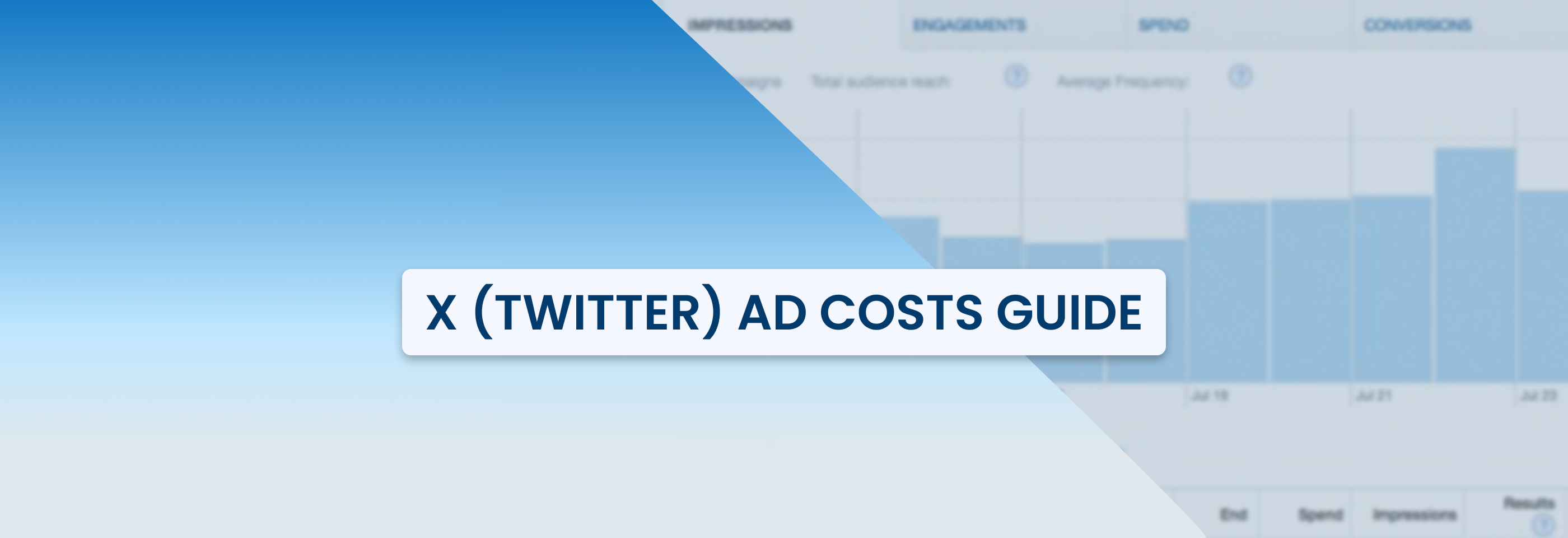Google Ads Keywords Basics: What You Need to Know
2024-05-21

In our previous article, we’ve talked about the most common Google ads mistakes advertisers can make. Choosing the wrong keywords for your ad campaigns is one of these mistakes, and this time, we’re going to explore the best practices for using keywords in Google ads to help you improve your ad performance and run the most relevant ads for your audience.
Without further ado, let’s begin with the basics of how keywords on Google work and what role they play in the success of your ads.
How Google ads keywords work
Basically, Google ads keywords are words or phrases that you can use to show your ads when people are looking for something specific on Google. Usually, they’ll be related to your brand and the products or services you provide.
When users look something up on Google search, Google will check the keywords in your campaign and try to match them with the words or phrases in the search queries.
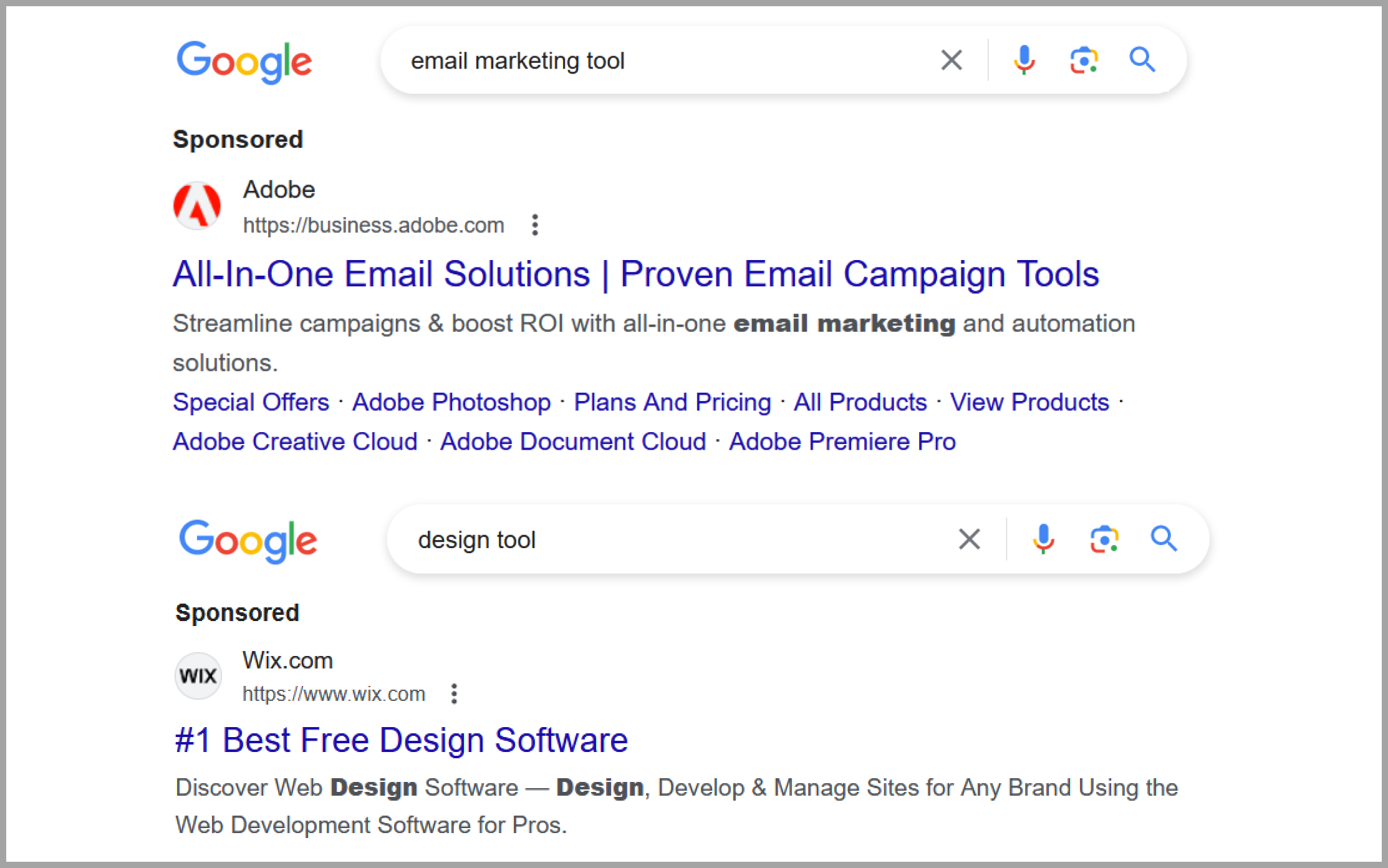
This is how paid Google search results look like for specific keywords
What’s the difference between keywords and search queries? Simply put, keywords are words that are used in your Google ad campaigns, and search queries or search terms are words that people use to look for information on Google Search. They are not the same thing, but they are very similar.
Choosing the right keywords can help you reach the right audience, get more clicks, a higher Quality Score, and better ad placements. This means more potential customers seeing your ad and, ideally, converting.
How to choose Google ads keywords
Choosing keywords for your ad campaigns is a bit like the game of Darts: it’s a hit-or-miss kind of situation, but some keywords can give you better ad performance than others.
So, how can you choose the best keywords to make sure you’re not missing your target? Let’s go through all the basic things you should do and understand about Google ads keywords to pick them right.
Keyword research for Google ads
Just like the target audience for your ads, ad keywords also need to be properly researched if you want to choose only the best ones. Keyword research helps you find the terms people use to search for products or services like yours, and it’s important for your Google ads’ performance because the right keywords will make your ads seen by the right people.
Here’s what you’ll need to do to conduct proper keyword research:
- Understand your audience: learn what your customers have in common (demographics, interests, behaviors, etc.), how they usually end up on your website, and what they do there to figure out which keywords might be useful for your Google ad campaigns;
- Brainstorm ideas: think about words or phrases people from different audience segments might use to search for your products or services;
- Use keyword tools: using various tools for keyword research can help you find the most fitting options for your campaigns and monitor the changes that happen to keywords over time;
- Check your competitors: you can also look at the keywords your competitors are using to find potentially profitable opportunities or exclude certain keywords from your campaigns to avoid high competition;
- Analyze and select your keywords: once your primary research is finished (remember that research should be a constant part of your strategy!), you can choose keywords that you’re going to use in your Google ads and group them based on specific characteristics.
Audience research should always be your starting point for creating your ad campaigns, so hopefully, you already know whom you want to target with your ads. If you’re not sure about this yet, check out our articles on how to find the right audience for your business and discover your customers’ needs for more in-depth tips.
Now, let’s get to one of the most important aspects of doing keyword research for your Google ads: using specific tools to do it correctly.
Using Google Keyword Planner for keyword research
One of the top tools for doing your keyword research is a free option provided by Google itself – Google Keyword Planner (keep in mind that you can use it only if you have a Google Ads account). Keyword Planner helps you find and choose the best keywords for your campaigns: you can check how often keywords are searched and how it changes over time, how much the keywords might cost, how competitive they are, and so on.

You can use Google Keyword Planner to check keywords similar to the ones you input
Here’s what it allows you to do:
- Discover new keywords based on the options you input or your website: this helps you find keywords similar to what your website ranks for and what you’re already using);
- Get search volume and forecasts for specific keywords that you provide: this helps you check the estimated number of clicks or conversions you can get from your keywords;
- Filter the results: you can do it based on locations, language, search networks, date, keyword text, average monthly searches, competition, bids, and so on. This allows you to quickly find the best options for your campaigns;
- Create a list of negative keywords: this can help you avoid showing your ads for undesirable terms.

You can also check Google keyword ideas for a specific website using Google Keyword Planner
There are also paid keyword research tools you can use to pick the keywords for your Google ad campaigns. Besides this free option, there are also paid keyword research tools that can help you make the right choice for your campaigns. For example, tools like SEMrush and Ahrefs allow you to check different types of data about the keywords you want to use. You can find out how often people search for a particular keyword (i.e., the monthly search volume) and how much it costs (i.e., the CPC).
Paid tools can also help you find keywords targeted by your competitors, build keyword lists around your seed keywords, discover long-tailed keyword variations, and get recommendations about keywords you can use in the future. All of this can help you run more successful ad campaigns and get a higher ROI.
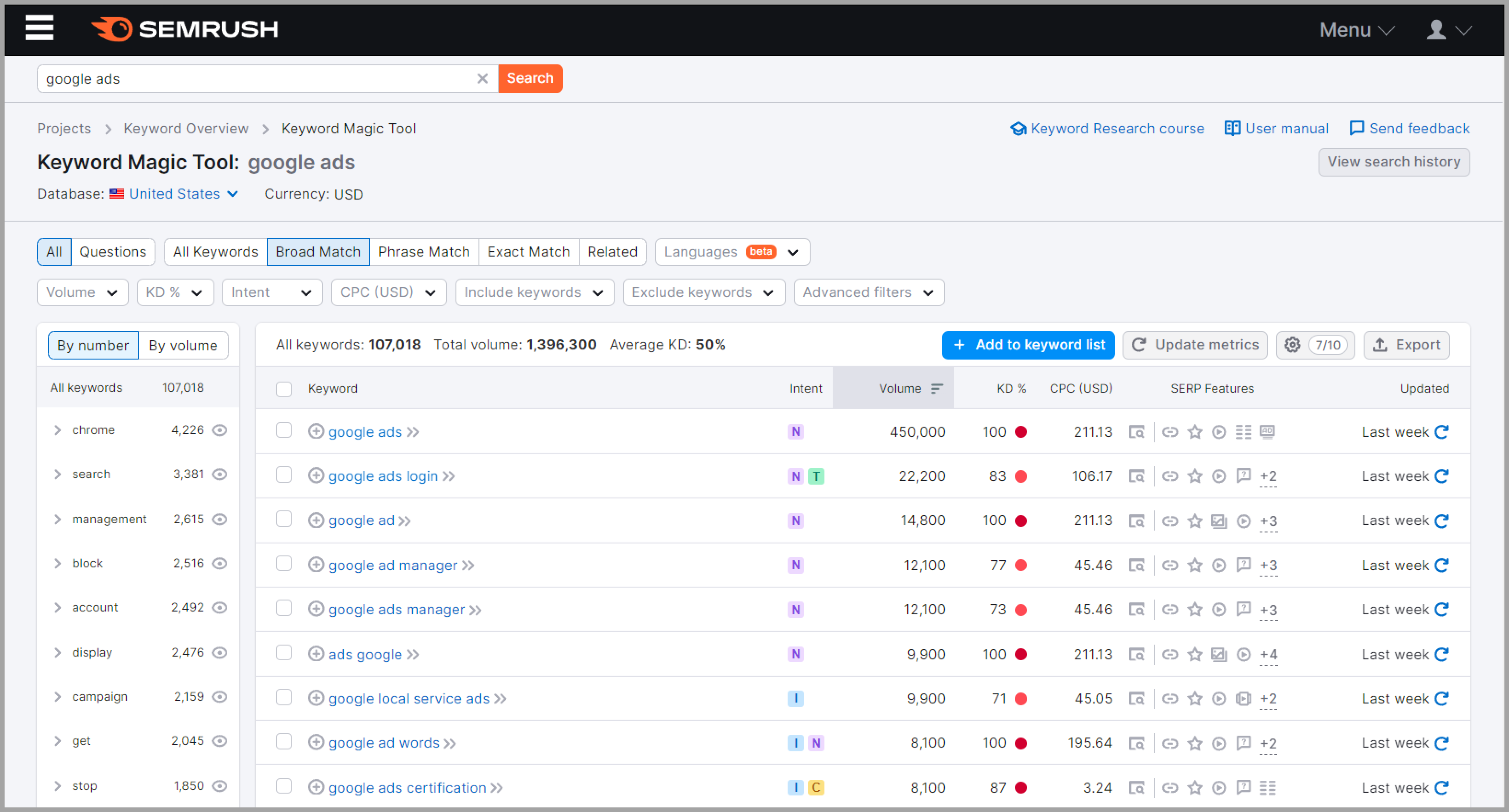
Tools like SEMrush allow you to check not only volumes and CPCs of keywords but also their intents, match types, and more
So, it’s really great that there are plenty of tools to help you with your keyword research. But what keywords are you supposed to choose?
Let’s consider different types of Google ads keywords and why you might want to use each of them.
Google ads keyword match types
The keyword match type you select for your campaigns determines how closely a user's search query should match your keyword for your ad to be displayed. Selecting the right match type is important because it affects when your ads will be shown, allowing you to go with a more general or a more narrow option.
There are three main types of keyword matches:
1. Broad match
If you use broad match keywords, your ads will show up in searches even if the words are in a different order, so it can be any variation of your seed keyword or even related terms.
For example, if your keyword is “gaming laptop”, your ad could appear for searches like “best gaming laptops”, “buy laptop for gaming”, “gaming computer”, or “laptop for video games”.
This is the most flexible match type that you can use for brand awareness campaigns, campaigns with a lot of conversions and Smart Bidding, or when you’re not seeing good results with other match types.
2. Phrase match
With phrase match, your ads will be displayed when someone uses search terms that include your keyword (or a part of it based on the meaning) along with other words.
In this case, if you’re using a “gaming laptop” keyword, your ad could appear for searches like “best gaming laptop deals”, “affordable gaming laptop”, “high-end gaming laptop”, or “gaming laptop reviews”.
This match type is more targeted than a broad match, so you can narrow down the scope of your campaign and get more relevant clicks. This can be great for campaigns aimed at conversions and other actions that belong to the middle or bottom levels of the sales funnel.
3. Exact match
Exact match keywords will trigger your ad only when someone types in your exact keyword, in the same order.
Your ad with the keyword “gaming laptop” will show up for searches that use the exact same words in the same order or very close variations, e.g., “gaming laptop” or “gaming laptops”.
This match type is by far the most precise, which makes it fitting for conversion campaigns. However, it may also limit the opportunities for your ads to be shown in some cases.

Google ads keyword match types
Keep in mind that the CPC for your keywords can depend on the match type you choose. For example, broad match keywords usually have a lower CPC because they are less competitive.
Phrase match and exact match keywords are more precise and targeted, so they are usually more expensive. However, exact match keywords also drive higher click-through rates, which often justifies the costs.

Conversion rates for different Google ads keyword match types. Source: Search Engine Land
In general, the more specific your match type is, the higher its CPC. But this can also mean better chances of reaching the right audience, so try balancing and testing different match types to manage your budget effectively while achieving good results.
Now, let’s get to another type of Google ads keywords that can help you run more successful ad campaigns.
Google ads negative keywords
Negative keywords are words and phrases you can select to prevent your ads from showing up in searches for them. Using negative keywords for Google ads is a must if you want to get only quality clicks and traffic, and avoid paying for showing your ads for search terms that don’t match what you’re offering.
Here are the main benefits of adding negative keywords to your Google ad campaigns:
- Reducing costs: you won’t be paying for clicks from people who aren’t exactly looking for what you’re offering;
- Boosting your Quality Score: without irrelevant clicks and traffic, your ads will get higher Quality Scores, which will affect when and where they are displayed;
- Getting more conversions: if you remove specific words from your campaigns, you can get more conversions and sales since you’ll be running ads only for people who are more likely to convert.
For example, you can use a negative keyword “cheap” to make sure your ads won’t show up for searches like “cheap gaming laptop”. This can be useful if you sell premium gaming laptops and want to avoid clicks from people looking for low-cost options.
Just like regular keywords, negative keywords have three match types: broad, phrase, and exact match. You can choose a specific match type based on what you want to achieve:
- Broad match negative keywords are better for excluding the general terms and related queries you don’t want your ads to show up;
- Phrase match negative keywords can be used when you want to exclude phrases similar to a specific keyword;
- Exact match negative keywords are your go-to if you want to exclude precise keywords from your ad campaigns.
But how can you find which keywords to exclude?
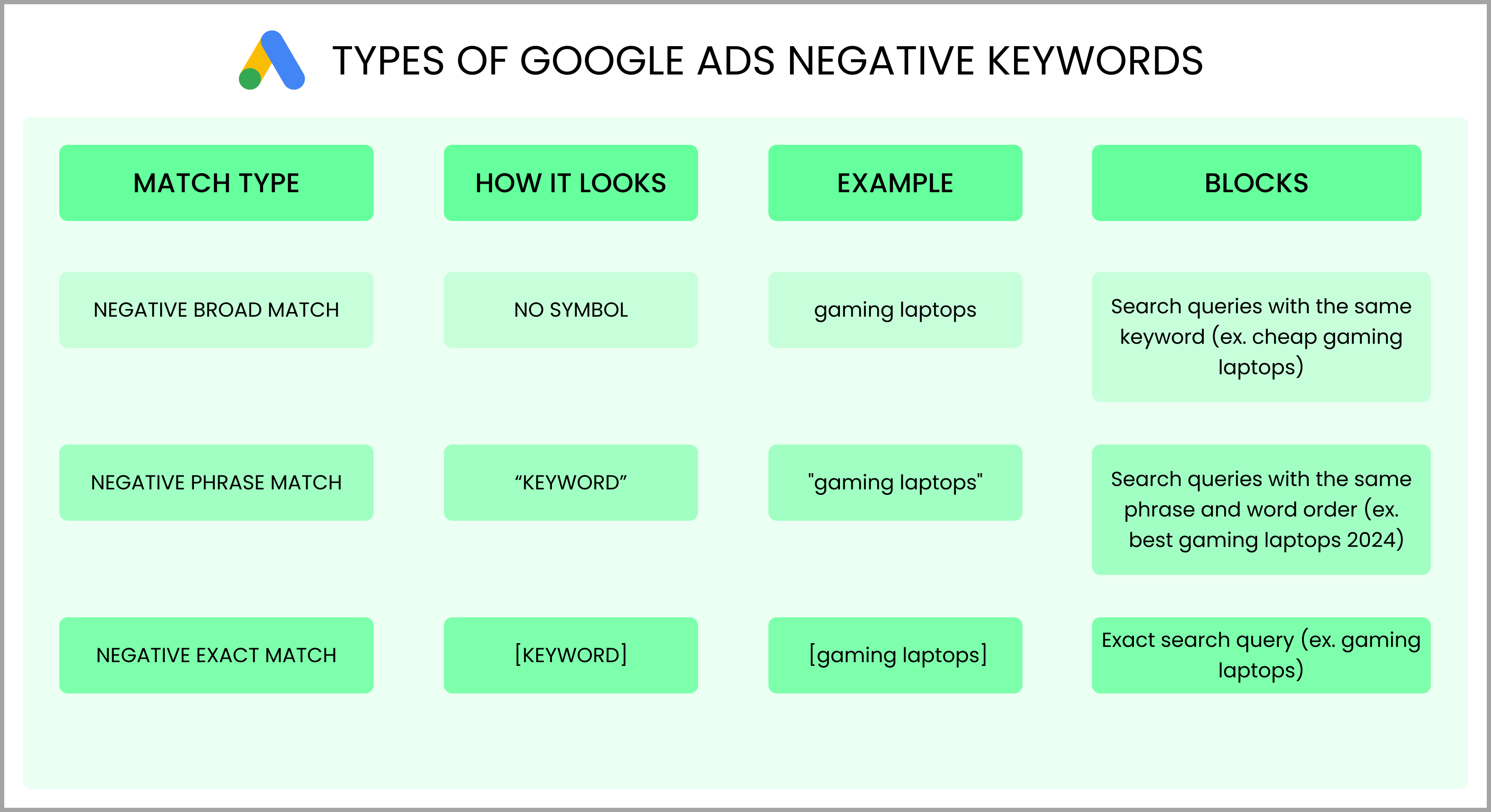
Different types of Google ads negative keywords help you reach specific keyword exclusion goals
Once again, use the Google Keyword Planner. While you’re in the process of discovering new keywords for your ads, pay attention to any options that are not very relevant to what you’re advertising or are missing the mark completely. You can also analyze your Search Terms Report (Campaigns => Insights and Reports) to find irrelevant options that you can then add to your negative keyword list.
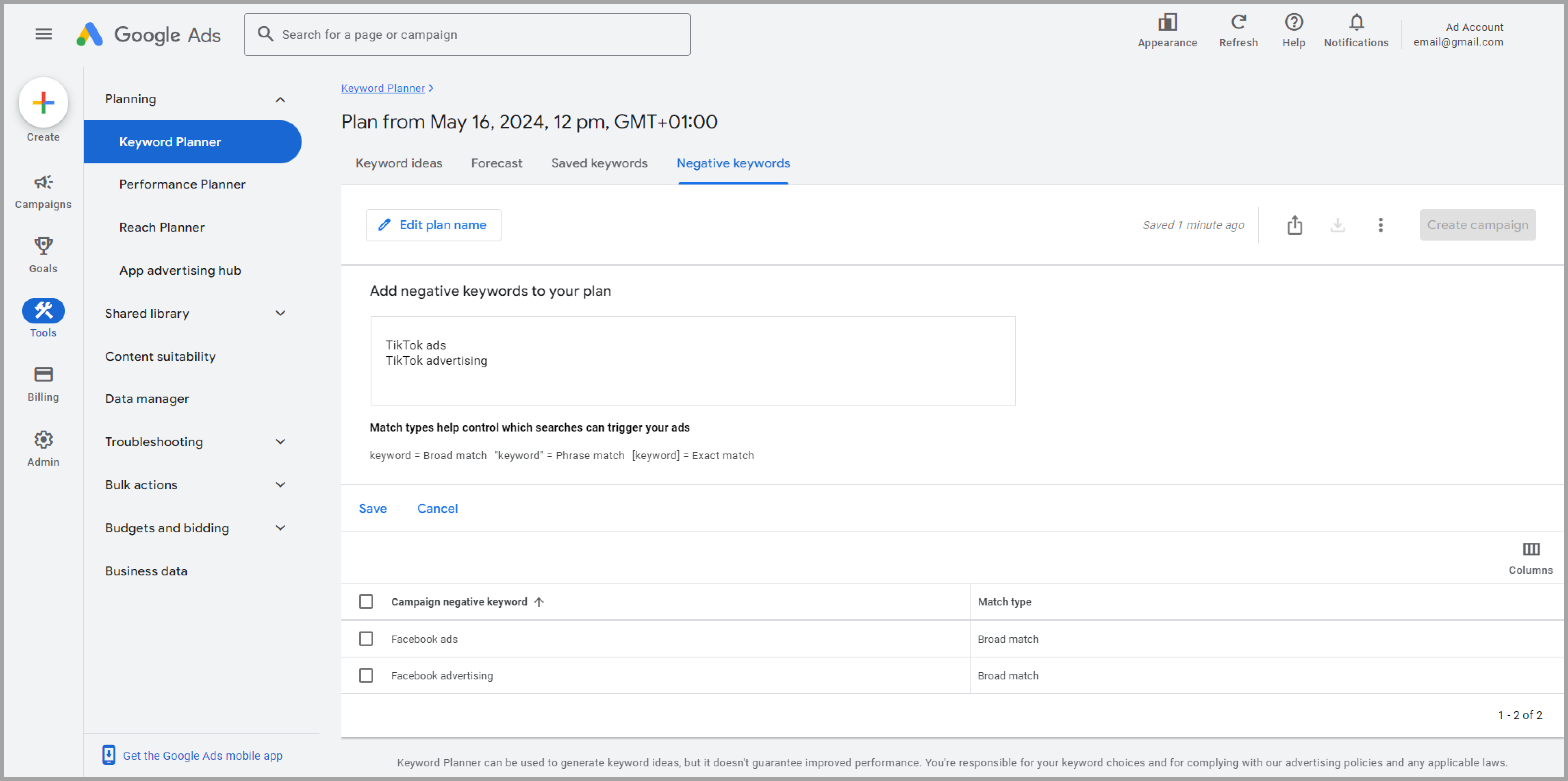
You can add negative keywords with different match types in Google Keyword Planner
Keep in mind that you can use negative keywords for the whole account, for specific campaigns, or ad groups.
Account-level negative keywords will apply to all of your Google ad campaigns, so you won’t have to add your lists to each campaign separately.
Campaign-level negative keywords can be applied to all ads in one campaign. These are useful if you want to exclude broad keywords from all of your ads.
Ad group-level negative keywords are more specific and can be applied only to certain ad groups. These are useful if you want to remove specific keywords only from some ad groups but leave them in others (which might be the case if you’re testing different keyword approaches).
Finally, you can follow these tips to make sure you’re using negative keywords correctly:
- Use singulars and plurals: this will help you eliminate all undesirable keywords from your ads;
- Try different match types: experiment with broad, phrase, and exact match negative keywords to see what works better for filtering out irrelevant traffic;
- Add underperforming keywords to your lists: check how your keywords are doing in the Search Terms report and add keywords with low CTR or Quality Scores to your negative keywords list – this can help you spend money only on keywords that actually bring traffic.
And don’t forget to always monitor your keywords’ and ads’ performance to choose only the best options for your campaigns. Checking how your customers feel about your products or services is also important: it allows you to find new negative keywords and keep your ads relevant.
Next, we have to consider several other important characteristics of Google ads keywords.
Keyword competition
If many advertisers want to use the same keyword, it becomes more competitive, and, logically, more expensive. In some cases, using high competition keywords might be justified since they are potentially the most profitable (as everyone is bidding for them). But mostly, using them can lead you to spend a lot of money without getting real results – competing with thousands of other advertisers is pretty hard, after all.
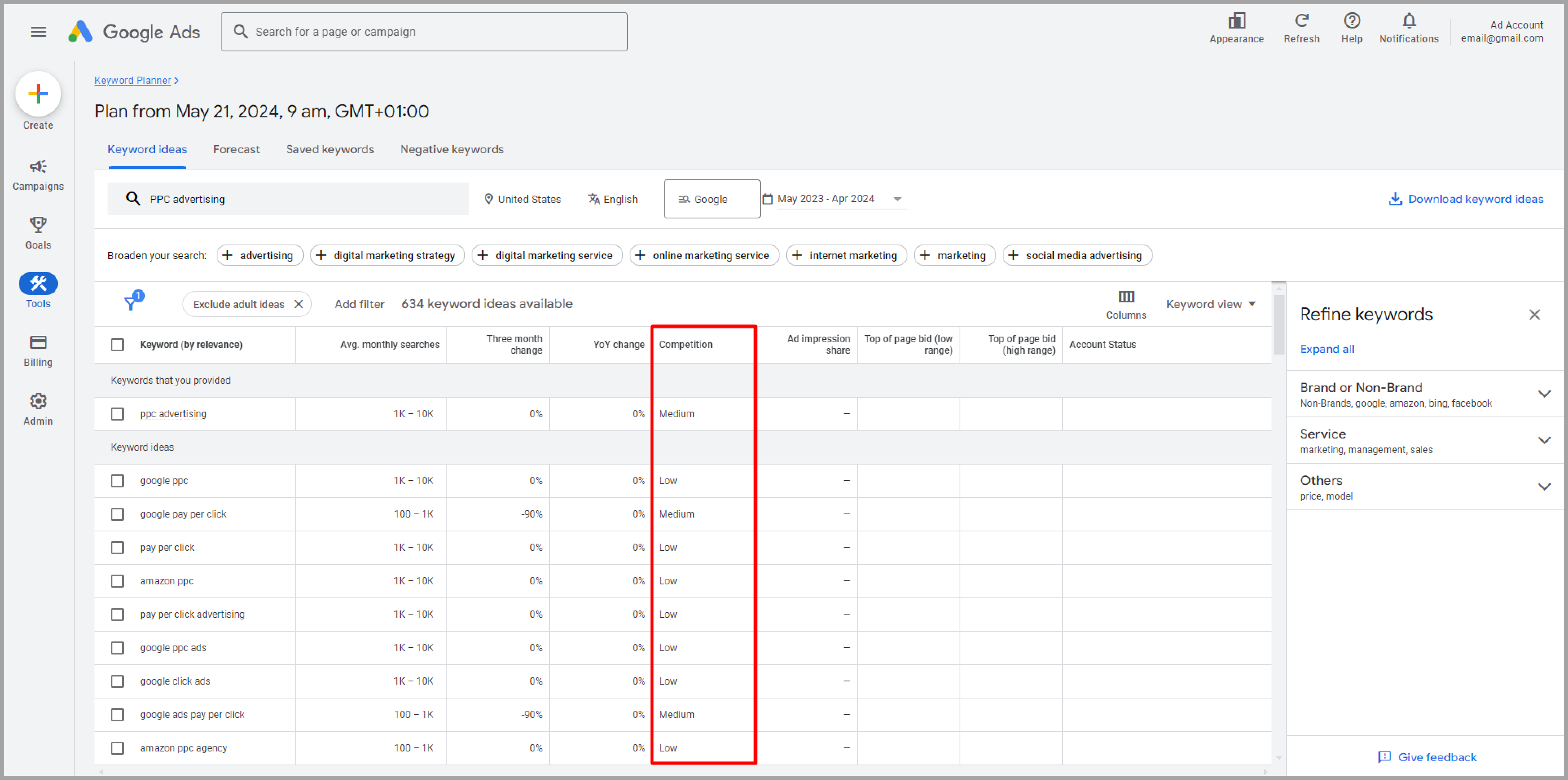
Checking the "Competition" column in Google Keyword Planner helps you understand if other advertisers actively bid for specific keywords
Here’s why you need to pay attention to how competitive your keywords are:
- Saving money: highly competitive keywords usually cost a lot to use. If you're on a tight budget, it's smarter to pick keywords that aren't as popular – you won’t exhaust your budget too quickly;
- Getting noticed: when you choose keywords that don’t have high competition, your ads will have a better chance of standing out. This potentially means that more people might see it and click on it;
- Being relevant: less competitive keywords can also often match exactly what your business offers (which includes long-tailed keywords). This means you can make your ads more relevant to highly specific keywords that not a lot of other advertisers use;
- Reaching the right people: knowing about keywords’ competition levels also helps you choose options that attract the right customers. That way, your ads can get in front of the people who are most likely to buy from you.
You can check the competition levels of keywords in the Google Keyword Planner after getting the results for “Keyword Ideas”. If you see that the competition is quite high for a certain keyword (keep in mind that you should also check the bids for it), it might be best to avoid using it in your ads. Even though it might be very popular, you should probably find more suitable options if you’re operating on a limited budget.
Keyword search volume
Another thing you should check about your Google ads keywords is the search volume, i.e., how many times people search for a particular word or phrase on Google. This is calculated as the average monthly volume based on the data for a whole year, so you shouldn’t expect 100% accuracy from this metric.
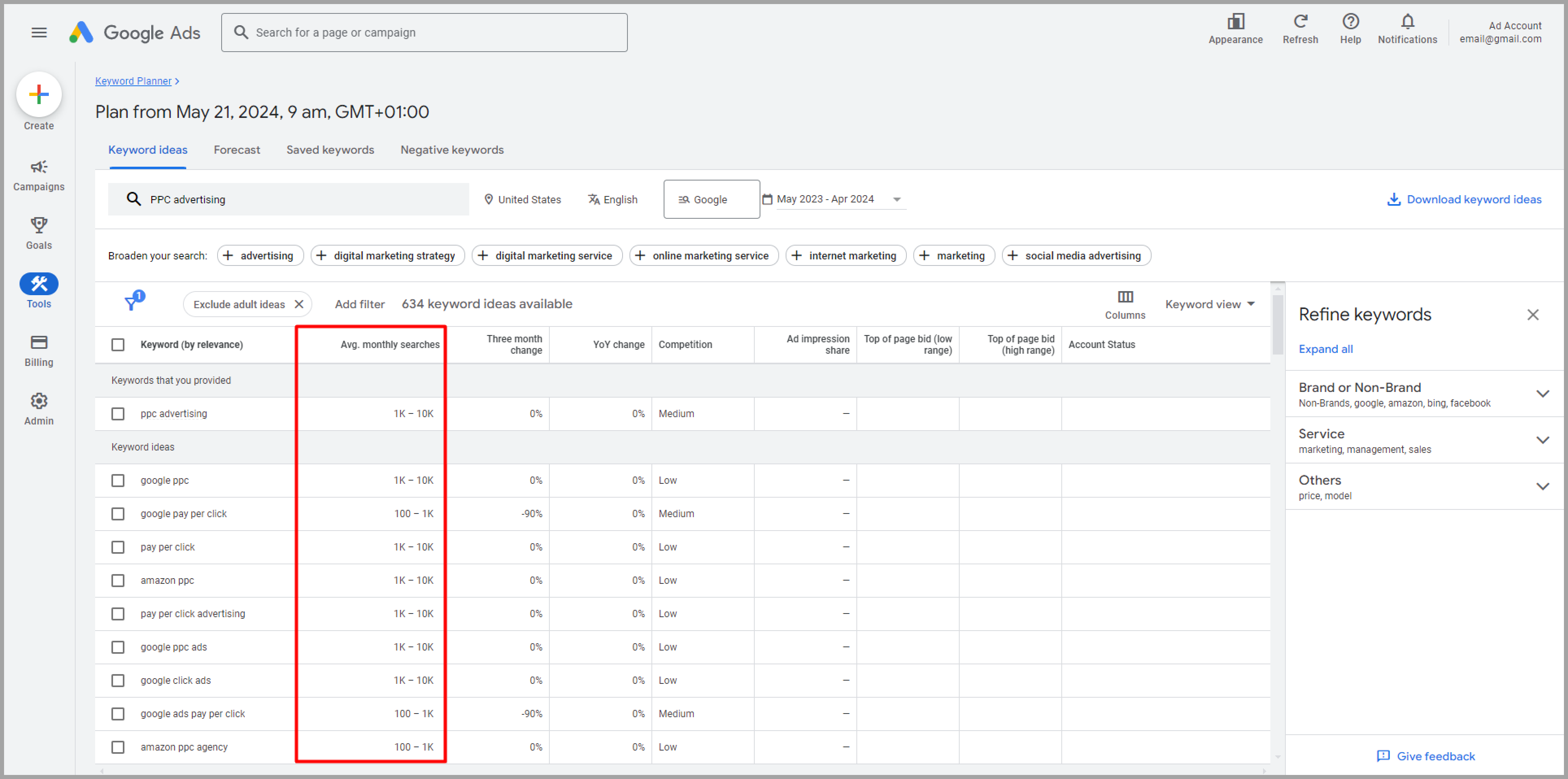
Search volume helps you understand how many times people look up specific keywords
That being said, it’s a useful estimation of how popular this keyword is in reality, which can help you make better choices instead of bidding for keywords that almost no one will use.
This is what you can see by checking a keyword’s search volume:
- How popular it is: if many people search for a specific keyword, it's popular. Using keywords with higher average monthly search volumes in your ads means that more people might see them;
- How competitive it is: popular keywords usually have more advertisers bidding for them, so they are likely to be more competitive and expensive as a result. This can make it harder and more expensive for your ads to get noticed. So, sometimes it's better to choose words with lower search volumes to avoid too much competition;
- How visible your ads can be: keywords with high search volumes are obviously searched for more frequently. So, if you use them in your ads, they’ll have a better chance of being seen by your target audience;
- How interested people actually are: high search volume can indicate that many people are interested in something related to your keyword if you’re using a phrase or broad match types. If your offers align with what people are looking for, using high-volume keywords can attract more potential customers.
You can also check this in the Google Keyword Planner. The baseline here is that if you want to get more eyes on your ads, you probably want to look for keywords with high enough search volumes.
At the same time, these keywords can be more expensive and also more broad, so make sure that you find some balance between how popular a specific keyword is, how expensive it is, and how exactly it matches your offers.
Keyword intent
Keyword intent is also important to know about when selecting keywords for your Google ad campaigns. Intent shows the reason behind why someone searches for a specific word or phrase, so it can help you determine whether it’s a good idea to bid for it or not.
There are four main types of keyword intent:
- Navigational intent: this is when someone searches for a specific website or webpage, e.g., “Facebook login”;
- Informational intent: this is when someone looks for answers to their questions. This could be anything from “how to cook rice” to “best restaurants in London”, and the main focus here is getting information;
- Commercial intent: this is when someone is in the research phase of making a purchase but hasn't yet decided where or what to buy. They might search for “best gaming laptops” or “iPhone 15 reviews” to compare options and gather information before making a decision;
- Transactional intent: this is when someone is ready to make a purchase or take a specific action. It can include searches like “buy gaming lapto” or “book flight to Paris”.
When selecting keywords for your Google ads, make sure that their intent fits your campaign goals. For example, if you’re trying to raise brand awareness, you can focus on keywords with informational intent to let more people know about what you’re offering.
If you want to get sales, though, it’s better to use keywords with commercial or transactional intent to give users a compelling reason to buy from you and make the purchasing process smooth and easy. Also, don’t forget to match your ad copy and the content of your landing page to the keyword intent: everything should match if you want to get a good Quality Score and keep your ads relevant.
To sum up, knowing people’s intentions behind each keyword helps you with the following:
- Boosting ad relevance: different keywords can have different intents. For example, someone typing “buy laptop” on Google probably wants to purchase shoes, while someone searching for “types of laptops” might just want to do some research. Choosing keywords that match what your ad offers will help you make sure that your ad is shown to people who are interested in what you're selling;
- Making ads more effective: when your ad matches what someone is looking for, they're more likely to click on it. So, bidding on keywords that match the intent of your potential customers can make your ads more effective and relevant;
- Reducing costs: keywords with more specific intents might have less competition, which can also make them cheaper to use in your ads. This means you can get more clicks with the same budget as before;
- Getting more conversions: understanding keyword intent can also help you attract people who are more likely to take action, like making a purchase or signing up for something. This can lead to higher conversion rates for your ads.
So far, we’ve talked about the basic characteristics of keywords that you can use in Google ad campaigns. But what combination of characteristics makes a good keyword?
How to choose the right Google ads keywords?
Here’s what the most profitable ad keywords share in common:
- High search volume: just as with SEO, you want to use Google ads keywords that many users are searching for. Try to avoid using keywords with too low search volume – otherwise, your ads might not be shown at all;
- Specificity: using specific and detailed keywords (e.g., long-tailed variations) can help you run more relevant ads for your audience and compete with other advertisers effectively;
- Close match: as we’ve explained, broad match keywords might be popular and cheaper, but they usually come with a low ROI. Consider bidding higher for phrase or exact match keywords – it’s likely to give you better results in the end.
However, always remember that what worked for one business might not work for the next, which brings us to the next important topic.
The importance of testing keywords
Testing different options is crucial if you want to find the best keywords for your ad campaigns. You can’t blindly copy what other advertisers are doing, so consider trying new keywords regularly and comparing their performance to find what works better.
And don’t forget to track CTR, conversion rate, CPC, and other metrics to analyze keyword performance. Once you get this data, you’ll be able to optimize your keywords by doing this:
- Keep top-performing keywords in your campaigns and raise their bids to get even better results;
- Remove low-performing keywords from your ads and add them to the negative keyword lists;
- Reduce bids for keywords that don’t perform well to avoid overspending;
- Adjust keyword match types if your CTR is low or your CPC is high.
By testing, tracking, and using the data wisely, you can make sure your ads are always working as good as they can to get you the results you want. Also, consider using automated rules for A/B testing to test and scale your ads faster.
Recap
If you want to get the best results from your Google ads, make sure to pick the right keywords:
- Begin by understanding your audience, doing keyword research, and using tools like Google Keyword Planner to find the best options;
- Match your campaign goals and consider what people are looking for with each keyword;
- Use negative keywords to avoid showing your ads to the wrong people;
- Keep an eye on how your keywords perform and adjust your strategy as needed.
By following these tips, you can make your ads more relevant, get more clicks, and achieve better results overall.

